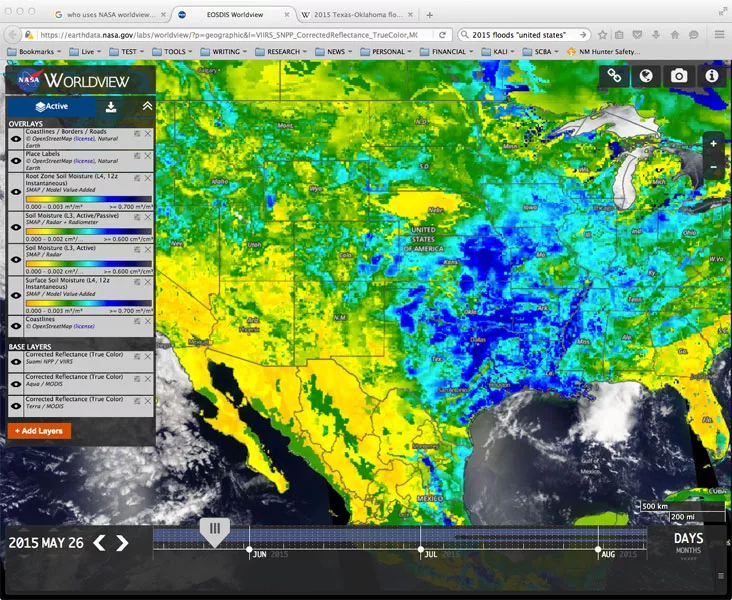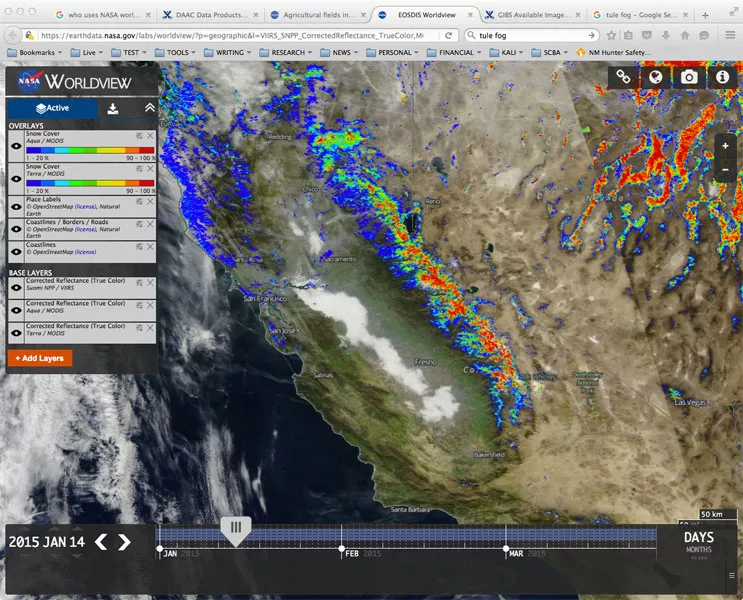By Laura Naranjo
In 1972, astronauts aboard the NASA Apollo 17 spacecraft snapped the first full-view image of Earth. The iconic photo was later dubbed “The Blue Marble.” Since then, NASA has sent an array of missions into space aimed at understanding life on Earth. Massive streams of data are now available, documenting everything from drought to hurricanes to plankton blooms. With such a wealth of data, how can scientists get a quicker look at what’s happening on Earth? Downloading and mapping data can be a very technical and time-consuming project.
As an answer, NASA developed Worldview, a Web-based application that renders satellite data as visible imagery overlaid on a geographical map of the planet. Worldview provides a quick glimpse of Earth to help users explore the data and find suitable products, many of them available in near-real time. Worldview currently offers multiple NASA data distributed from the NSIDC Distributed Active Archive Center (DAAC), including products from the NASA Moderate Resolution Imaging Spectroradiometer (MODIS) satellite instrument, the Soil Moisture Active Passive (SMAP) mission, and the Advanced Microwave Scanning Radiometer-EOS (AMSR-E) instrument. NSIDC DAAC data users can access Worldview visualizations directly from the relevant NSIDC DAAC data set overview pages.
Interactive visualization
Worldview offers an easy-to-use interface. Users start with a map showing a true-color view of Earth’s surface, onto which they can add layers of data. These layers show up as additional imagery or as pixels of information accompanied by a color scale. Layers appear in a palette, and can be rearranged and turned off or on, revealing various views. A time slider allows users to choose a specific date, and bars in the slider show the time range available for each layer. In addition, users can pan across the map, zoom into an area of interest, or choose additional map views of the North or South Pole. Images can be shared or output into JPEG, PNG, GeoTIFF, and KML formats, and users can download the data underlying each layer.
Most base layers that rely on satellite imagery are viewable back to 2012, with the exception of the static NASA Blue Marble data, which were compiled in 2004. The entire time series of SMAP products, beginning in April 2015, as well as the entire AMSR-E time series, beginning in June 2002, are viewable in Worldview. MODIS are currently viewable back to 2012, but the complete instrument time series will eventually be included.
Data check
Andrew Slater, a research scientist at NSIDC, uses Worldview as a tool to view snow and sea ice. “It’s a very easy and rapid look at the data,” Slater said. Slater uses MODIS data to study snow hydrology across the western United States. Using Worldview can be a time-saving first step in the search for the right data. A quick check on Worldview helps Slater check data quality before he begins investigating a particular basin. He said, “Is that basin continuously cloud-covered so that you don’t have good MODIS data at the surface? Is a particular line of study worth pursuing?” One of the challenges of using certain satellite data to study the cryosphere is distinguishing white clouds high in Earth’s atmosphere from snow and ice blanketing the land surface below. “In Worldview, you can quite often see if something is cloud covered or not cloud covered—whether it’s snow. You can see if it’s been falsely classified in the data,” Slater said.
Converting pixels and bits of satellite data into usable formats often means scientists pull double duty as programmers to extract information meaningful to their research. “A minute on Worldview can save an hour of downloading data, coding, and plotting,” Slater said. “That quick availability and high-resolution imagery certainly helps.”
Available through the NASA Earthdata Web site, Worldview is continually updated and includes approximately 200 data products. The newest imagery is often available within hours. NASA encourages its Earth science missions to add more products. In fact, the SMAP mission ensured that 45 data layers of its soil moisture, freeze/thaw, and carbon products were available in Worldview at the same time data were released to the public. Data supplied through Worldview are freely available, extending the way scientists understand our blue marble.
For more information
NSIDC DAAC products available in Worldview
Advanced Microwave Scanning Radiometer-EOS (AMSR-E)
AMSR-E/Aqua L2A Global Swath Spatially-Resampled Brightness Temperatures (AE_L2A)
AMSR-E/Aqua L2B Global Swath Surface Precipitation GSFC Profiling Algorithm, Version 3 (AE_Rain)
AMSR-E/Aqua Daily L3 6.25 km 89 GHz Brightness Temperature Polar Grids, Version 3 (AE_SI6), North
AMSR-E/Aqua Daily L3 12.5 km Brightness Temperature, Sea Ice Concentration, & Snow Depth Polar Grids, Version 3 (AE_SI12), North
AMSR-E/Aqua Daily L3 25 km Brightness Temperature & Sea Ice Concentration Polar Grids, Version 3 (AE_SI25), North
Soil Moisture Active Passive (SMAP) mission
SMAP L1B Radiometer Half-Orbit Time-Ordered Brightness Temperatures (SPL1BTB)
SMAP L3 Radiometer Global Daily 36 km EASE-Grid Soil Moisture, Version 1 (SPL3SMP)
SMAP L1C Radiometer Half-Orbit 36 km EASE-Grid Brightness Temperatures, Version 3 (SPL1CTB)
SMAP L2 Radiometer Half-Orbit 36 km EASE-Grid Soil Moisture, Version 3 (SPL2SMP)
SMAP L3 Radar Global Daily 3 km EASE-Grid Soil Moisture, Version 3 (SPL3SMA)
SMAP L3 Radar/Radiometer Global Daily 9 km EASE-Grid Soil Moisture, Version 3 (SPL3SMAP)
SMAP L3 Radar Northern Hemisphere Daily 3 km EASE-Grid Freeze/Thaw State (SPL3FTA)
SMAP L4 9 km EASE-Grid Surface and Root Zone Soil Moisture Analysis Update, Version 2 (SPL4SMAU)
SMAP L4 9 km EASE-Grid Surface and Root Zone Soil Moisture Geophysical Data, Version 2 (SPL4SMGP)
SMAP L4 Global Daily 9 km Carbon Net Ecosystem Exchange, Version 2 (SPL4CMDL)
Moderate Resolution Imaging Spectroradiometer (MODIS)
MODIS/Terra Sea Ice Extent 5-Min L2 Swath 1km, Version 6 (MOD29)
MODIS/Aqua Sea Ice Extent 5-Min L2 Swath 1km, Version 6 (MYD29)
MODIS/Terra Snow Cover 5-Min L2 Swath 500m, Version 6 (MOD10_L2)
MODIS/Aqua Snow Cover 5-Min L2 Swath 500m, Version 6 (MYD10_L2)

